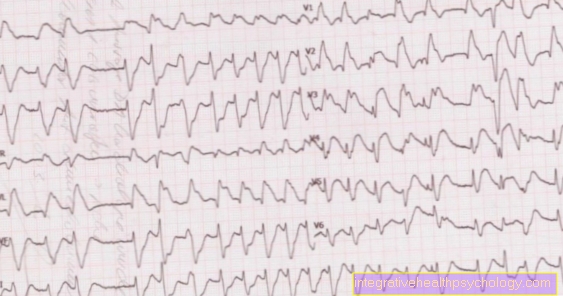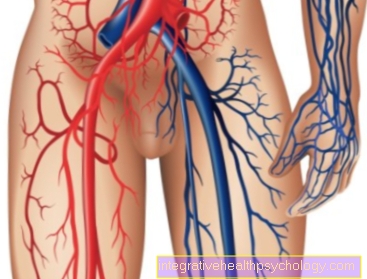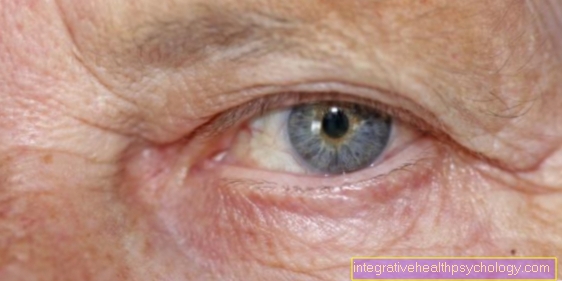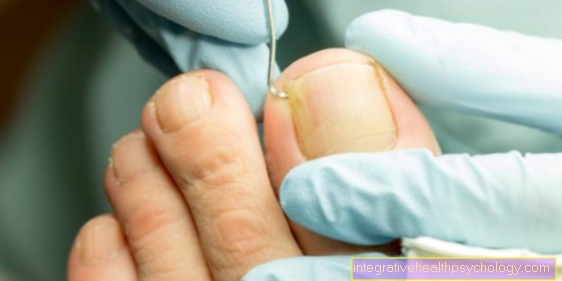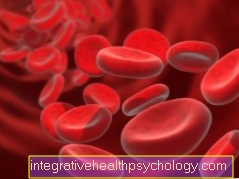Cause of diseases in the blood
introduction
The causes of haematological diseases are very diverse and in some cases very complex. Many diseases of the haematological type can be largely restricted to changes in the genetic make-up in the form of mutations and other chromosomal anomalies. These genetic changes in the form of e.g. mutations lead to important cellular processes for which the genetic material (Genome) are responsible, run incorrectly or even not at all. These processes are often involved in the regulation of the so-called cell cycle. The cell cycle regulates the growth and the programmed death of a cell, and thus contributes to maintaining cell balance. Changes in these regulatory processes can lead to uncontrolled cell growth, which ultimately leads to cancer / tumor can contribute.
leukemia

A special form of hematological tumors is called leukemia designated. The word leukemia comes from the Greek and means "white blood". Here, as part of genetic changes, uncontrolled growth of white blood cells takes place. The leukemias can be classified according to the duration of their emergence, ie acute or chronic and which cell family they come from, that is lymphatic (from lymphocyte precursors) or myeloid (from granulocyte precursors).
According to this, 4 types of leukemia can be distinguished from one another:
- Acute myeloid leukemia (so-called AML),
- Chronic myeloid leukemia (so-called CML),
- Acute lymphoblastic leukemia (so-called ALL) and finally
- chronic lymphocytic leukemia (so-called CLL).
All leukemias have in common that they lead to an excess of progenitor cells Bone marrow and in blood to lead. This excess of precursor cells displaces healthy blood formation in the bone marrow and thus the other important blood cells that are involved, for example, in the transport of oxygen and blood clotting. Leukemias are thus expressed, for example, as one Anemia (anemia) as the healthy ones red blood cells be displaced by leukemia. The ALL is the most common Leukemia in children and is generally one of the most common types of cancer in childhood.
Lymphoma
Another hematological disease includes the so-called Lymphoma (Lymph gland cancer). These are divided into numerous categories and count, as opposed to leukemia, to the solid tumors of the Lymphatic system. Here one differentiates Hodgkin lymphoma from so-called. Non-Hodgkin lymphoma. These can often only be differentiated under the microscope or with the help of specific detection methods. Lymphoma can occur anywhere in the body and arise mainly from so-called B cells, a sub-form of the Lymphocytes. The lymphomas can also be divided into low-grade and high-grade (slow and fast-growing) lymphomas. Paradoxically, the highly malignant lyymphomas are easier to treat than the low-malignant ones because they grow faster and are therefore more sensitive to you chemotherapy speak to. The diagnosis of which type of lymphoma is present is mainly histological (microscopic), cytochemical (cell chemical processes) and genetically.
Storage diseases
The so-called storage diseases as the cause of diseases in the blood include iron storage disease and copper storage disease. The body does not manage to excrete sufficient amounts of iron or copper and stores them in various organs and tissues. The stored metal also causes malfunctions, as excessive amounts of metal are toxic. These mainly affect the heart, the blood-forming organs and the organs of the lymphatic system. Hemoglobin formation disorders include diseases such as sickle cell anemia and thalassemia. In these diseases there is an impairment in the formation of the red blood pigment hemoglobin. Hemoglobin is mainly involved in the transport of oxygen and is not produced sufficiently or only incorrectly in the diseases mentioned above. This defective hemoglobin is removed from the body mainly via the spleen and liver, with the patient often having too low hemoglobin levels, which is reflected in the picture of anemia.
Read more about storage diseases in our article: Storage diseases - what are they?

